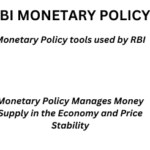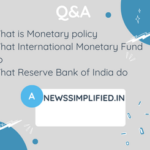RBI keeps the Repo Rate unchanged


RBI (The Reserve Bank of India) , as inflation continues to remain sticky, on Thursday decided to keep the policy repo rate unchanged at 6.50 percent. The central bank has already increased the repo rate by a total of 250 bps since May 2022. RBI to remain focused on withdrawal of monetary policy accommodation, says Governor Das.
RBI marginally raises the GDP growth projection for FY24 to 6.5 percent from an earlier estimate of 6.4 percent.
The GDP grew 7 percent in 2022-23, indicating the economic conditions were resilient.
Core inflation remains sticky.
RBI governor Shaktikanta Das has proposed to expand scope of United Payments Interface (UPI) by permitting operations of pre-sanctioned credit lines by banks through UPI. This initiative will encourage innovations.
Repo Rate: 6.50 %.
The reverse repo rate: 3.35%
The Marginal Standing Facility (MSF): 6.75%
The Bank Rate: 6.75 %
The Standing Deposit Facility rate: 6.25 %
Cash Reserve Ratio: 4.50%
Statutory Liquidity Ratio: 18.00%
LEARNING FROM HOME/WITHOUT CLASSES/BASICS
The Reserve Bank of India is the supreme monetary and banking authority in the country. It keeps the cash reserve of all scheduled banks and hence is known as Reserve Bank. It was established on April 1, 1935. Though originally privately owned, since its nationalization in 1949, the Reserve Bank is fully owned by the Government of India. Its main function includes; formulating, implementing, and monitoring the monetary policy, prescribing broad parameters of banking operations within which the country’s banking and financial system functions, Managing the Foreign Exchange Management Act, 1999, Issues and exchanges or destroying currency and coins not fit for circulation, Banker to the Government: performs merchant banking function for the central and the state governments; also acts as their banker.
RBI Governor SHAKTIKANTA DAS
BANK RATE: It is a rate of interest at which the central bank lends money to the lower bank. It is a quantitative method of credit control.
REPO RATE: Also known as repurchased auction. When there is a liquidity shortage, the government repurchases government securities, and payment is made to banks. It adds liquidity to the market. It simply means the repo rate is the rate at which RBI lends money to commercial banks against the pledge of government securities whenever the banks are in need of funds to meet their day-to-day obligations.
REVERSE REPO RATE: When the government sells dated government securities to banks to suck considerable liquidity in the market. Both repo and reverse repo rates are liquidity Adjustment Ratios (LAR).
MONETARY POLICY: Monetary policy is the macroeconomic policy laid down by the central bank. It involves the management of money supply and interest rate and is used by the government of a country to achieve macroeconomic objectives like inflation, consumption, growth and liquidity. Monetary policy can be expansionary and contractionary in nature. Increasing the money supply and reducing interest rates indicate an expansionary policy. The reverse of this is a contractionary monetary policy.
MONETARY POLICY TOOLS
To control inflation, the Reserve Bank of India needs to decrease the supply of money or increase the cost of funds in order to keep the demand for goods and services in control.
QUANTITATIVE TOOLS
The tools applied by the policy impact the money supply in the entire economy, including sectors such as manufacturing, agriculture, automobile, housing, etc.
Reserve Ratio:
Banks are required to keep aside a set percentage of cash reserves or RBI approved assets. Reserve ratio is of two types:
Cash Reserve Ratio (CRR);
Statutory Liquidity Ratio (SLR) – Banks are required to set aside this portion in liquid assets such as gold or RBI-approved securities such as government securities. Banks are allowed to earn interest on these securities, however, it is very low.
Open Market Operations (OMO):
In order to control the money supply, RBI buys and sells government securities in the open market. These operations conducted by the Central Bank in the open market are referred to as Open Market Operations.
The objective of OMOs are to keep a check on temporary liquidity mismatches in the market, owing to foreign capital flow.
QUALITATIVE TOOLS
Unlike quantitative tools which have a direct effect on the entire economy’s money supply, qualitative tools are selective tools that have an effect in the money supply of a specific sector of the economy.
Margin requirements – RBI prescribes a certain margin against collateral, which in turn impacts the borrowing habit of customers. When the margin requirements are raised by the RBI, customers will be able to borrow less.
Moral suasion – By way of persuasion, RBI convinces banks to keep money in government securities, rather than certain sectors.
Selective credit control – Controlling credit by not lending to selective industries or speculative businesses



0 Comments